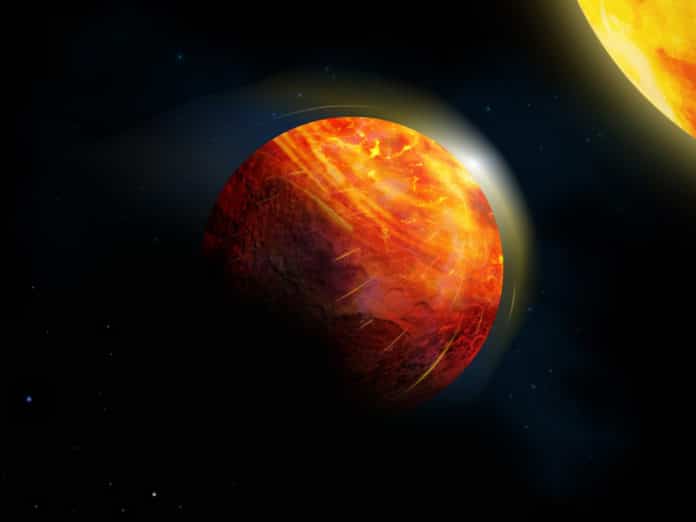Lava planets are a class of rocky exoplanets that orbit so close to their star that their surface parts are molten. Indeed, dayside temperatures can be hot enough to maintain a rock vapor atmosphere detectable through transit and eclipse spectroscopy, as well as phase curves.
According to scientists from McGill University, York University, and the Indian Institute of Science Education, the atmosphere and weather cycle of at least one such exoplanet is even stranger, featuring the evaporation and precipitation of rocks, supersonic winds that rage over 5000 km/hr, and a magma ocean 100 km deep.
One planet is K2-141b, an Earth-size exoplanet with a surface, ocean, and atmosphere all made up of the same ingredients: rocks. Using computer simulations, scientists predicted the conditions on K2-141b. The extreme weather forecasted by their analysis could permanently change the surface and atmosphere of K2-141b over time.
In investigating the exoplanet’s illumination pattern, the team found that around two-thirds of K2-141b faces perpetual daylight – as opposed to the illuminated hemisphere we are used to on Earth. As K2-141b belongs to a subset of rocky planets that orbit very close to their star, this proximity keeps the exoplanet gravitationally locked in place.
Nicolas Cowan, a professor in the Department of Earth & Planetary Sciences at McGill University, said, “The night side experiences frigid temperatures below -200 C. At an estimated 3000 C, the dayside of the exoplanet is hot enough to not only melt rocks but vaporize them as well, ultimately creating a thin atmosphere in some areas. Our finding likely means that the atmosphere extends a little beyond the shore of the magma ocean, making it easier to spot with space telescopes.”
The rock vapor atmosphere created by the extreme heat undergoes precipitation. Just like the water cycle on Earth, where water evaporates, rises into the atmosphere, condenses, and falls back as rain, so too does the sodium, silicon monoxide, and silicon dioxide on K2-141b. The mineral vapor formed by evaporated rock is swept to the frigid night side by supersonic winds, and rocks “rain” back down into a magma ocean. The resulting currents flow back to the exoplanet’s hot dayside, where rock evaporates once more.
Scientists noted, “The next step will be to test if these predictions are correct. We now have data from the Spitzer Space Telescope that should give them a first glimpse at the day-side and night-side temperatures of the exoplanet.”
With the James Webb Space Telescope launching in 2021, they will also verify whether the atmosphere behaves as predicted.
Journal Reference:
- T. Giang Nguyen et al. Modelling the atmosphere of lava planet K2-141b: implications for low and high-resolution spectroscopy. Monthly Notices of the Royal Astronomical Society, DOI: 10.1093/mnras/staa2487
